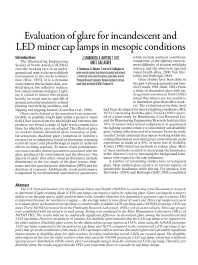Mining Publication: Evaluation of Glare for Incandescent and LED Miner Cap Lamps in Mesopic Conditions
Original creation date: June 2009
The U.S. National Institute for Occupational Safety and Health (NIOSH) is conducting mine illumination research to determine if light-emitting diode (LED) cap lamps can improve safety by reducing glare. Glare can impede a miner's ability to see hazards and to safely perform their work. Another objective is to determine if a person's age is a factor This is important because the workforce is aging - the average miner is now about 43 years old. Three cap lamps were used to evaluate glare: an incandescent cap lamp, a commercially available LED cap lamp and a NIOSH prototype LED cap lamp. Thirty NIOSH personnel from the Pittsburgh Research Laboratory (PRL) served as test subjects. Three age groups were established with ten subjects in each group. Testing was conducted in the Mine Illumination Laboratory (MIL) of NIOSH PRL. The results indicate no statistically significant difference in discomfort glare among the incandescent and LED cap lamps. However, an analysis of variance for disability glare indicates that the LED cap lamps were superior for the older subjects Disability glare scores for the oldest subject group improved 53.8% when using the NIOSH prototype LED cap lamp compared to the incandescent cap lamp and 36.5% compared to the commercial LED cap lamp. It appears that, given the conditions of this study, LED cap lamps will not increase discomfort glare and can enable significant improvements in disability glare for older workers. It is also evident that not all LEDs are created equal. The disability glare improved the best for older workers when they used the NIOSH prototype LED cap lamp, which has a different spectral power distribution (SPD) (more short wavelength energy) than the commercial LED cap lamp. Therefore, for disability glare, the results suggest that the SPD is an important factor to consider in cap lamp design.
Authors: JJ Sammarco, AG Mayton, TJ Lutz, S Gallagher
See Also
- Age Awareness Training for Miners
- Discomfort Glare Comparison for Various LED Cap Lamps
- Do Light-Emitting Diode Cap Lamps Enable Improvements in Miner Safety?
- Evaluation of Peripheral Visual Performance When Using Incandescent and LED Miner Cap Lamps
- Experiments on Personal Equipment for Low Seam Coal Miners: IV. Incorporating Coiled Cord Into Cap Lamp Battery Cords
- Illumination
- NIOSH Illumination Research Addresses Visual Performance Needs with LED Technology
- The Potential Impact of Light Emitting Diode Lighting on Reducing Mining Injuries During Operation and Maintenance of Lighting Systems
- Technological Aspects of Solid-State and Incandescent Sources for Miner Cap Lamps
- Visual Performance for Incandescent and Solid-State Cap Lamps in an Underground Mining Environment
- Visual Performance for Trip Hazard Detection When Using Incandescent and LED Miner Cap Lamps
- Content source: National Institute for Occupational Safety and Health, Mining Program


 ShareCompartir
ShareCompartir
